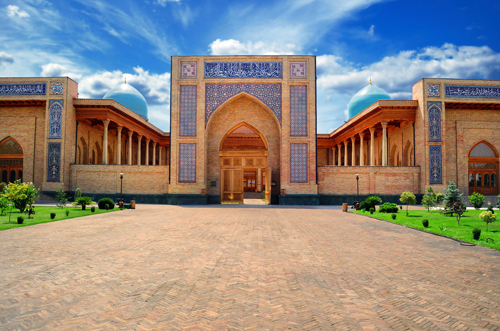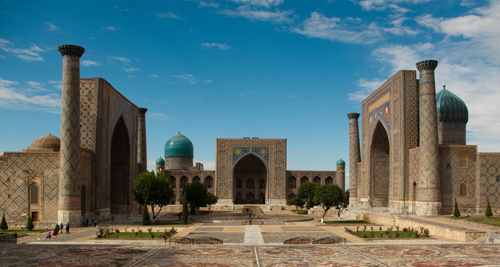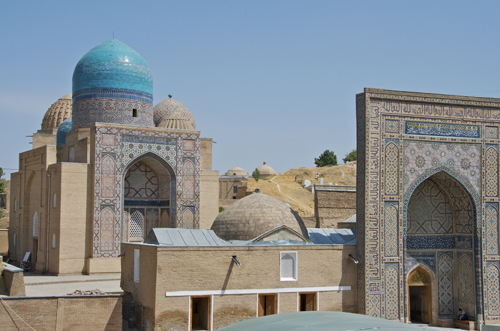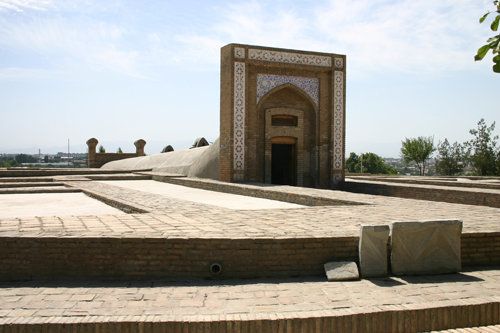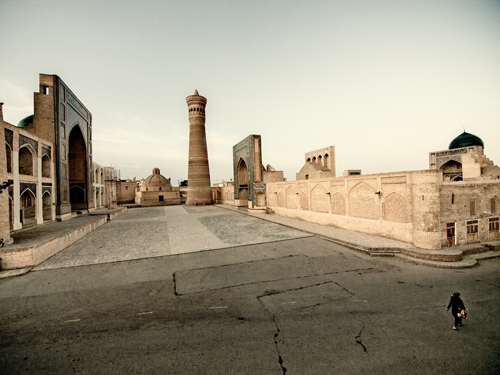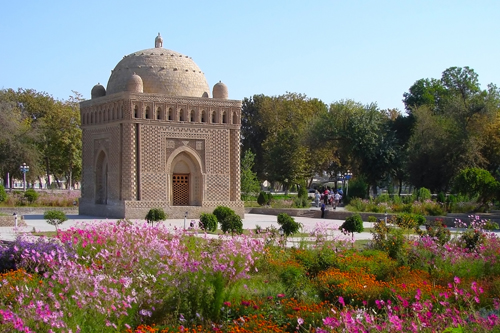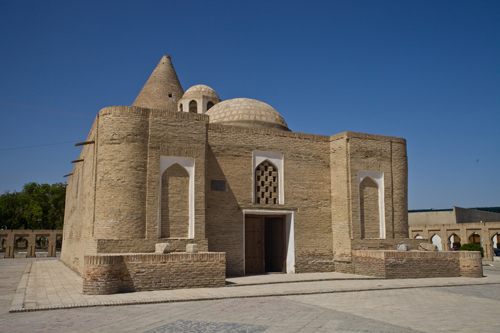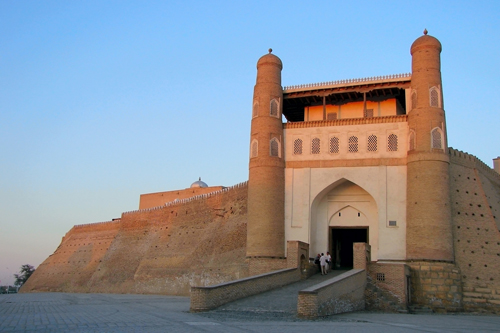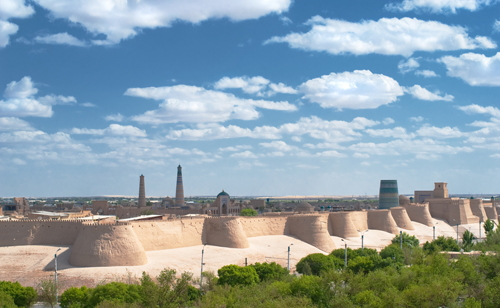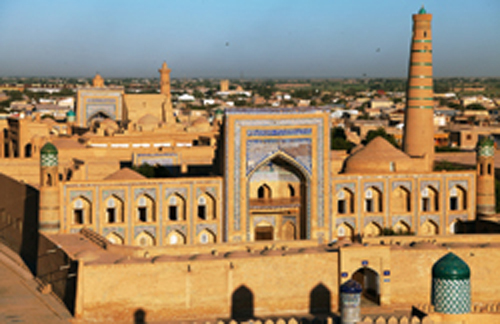Central Asia Traveling in Uzbekistan
Uzbekistan, the epitome of ancient Oriental mystery and beauty, is the longest part of our Five Stans tour because it is such a spectacular part of the Central Asia tour. It has so many highly popular travel destinations such as Samarkand, Bukhara and Khiva. Traveling to Uzbekistan is truly an adventure with something for everyone! The abundance of captivating historical sites and the lovely environmental scenery of Uzbekistan help to make it the most fascinating experience of your Central Asia tour. In Uzbekistan one can find influences of many oriental cultures, along with the tales of mystery and romance that are embodied everywhere. Situated between two rivers in the center of Central Asia, the Republic of Uzbekistan borders the other Central Asian countries of Afghanistan, Kazakhstan, Turkmenistan, Kyrgyzstan, and Tajikistan. The climate is generally bright and sunny with little rainfall. If your Central Asia tour brings you to Uzbekistan in the fall season, you will be in time for the bountiful autumn harvests. Uzbekistan boasts an incredible variety of tantalizing fruits and vegetables.
The entire region of Central Asia is rich in ancient history and wonderful mosques and monuments. It is a land of legends, and tour guides may regale visitors on the Central Asia tour with marvelous tales evoking images of fortresses and castles, maidens in bejeweled gowns, and warriors riding into battle with swords and knives clashing. Various foreign invaders have attacked and conquered these lands causing terrible destruction; yet every time the cities of this region have risen up from the ashes and claimed their former power and glory. Such is the spirit of Central Asia; subjugated but not destroyed. Devastated, but never eradicated from the face of the earth. As you progress on your Central Asia tour, the historical archeological structures, in all their brilliant elegance, are testaments to the great strength of spirit of the people of Central Asia.
There are so many places in Uzbekistan to see on a Central Asia tour that it is nearly impossible to list them all. Because the region is so ancient, there are a great many amazing historical buildings to visit, as well as a variety of museums housing fascinating archeologic and anthropological finds. The architecture in particular is of such intensely profound beauty that words fail to adequately describe it. The magnificent sight of sky-blue domes, intricate white and teal tile ornamentation and detailed engraving will absolutely take your breath away. Once you have experienced the magic of a Central Asia tour you will be forever enchanted.
Tashkent
Once an ancient city, Tashkent today is the attractive and vibrant capital of Uzbekistan with lush greenery and clear water. Known as the “capital of friendship”, Tashkent has been the location of many international conferences and symposiums. On the Central Asia tour you will find that this city is a unique blend of old and new. Some of the more modern landmarks include the Chorsu Tourist Complex, The People’s Friendship Palace, and the Tashkent Metro station. Tashkent has always been a major transportation link between Europe and the Far East. Formerly known as Chach, Shash, and Binkent, most of its architecture was destroyed as a result of the 1917 revolution, and then a devastating earthquake in 1966. Rebuilt as a modern Uzbekistan city, remnants of Tashkent’s past can be seen on a Central Asia tour by visiting buildings in the old town, located on a hill to the west overlooking the new town.
In addition to the sixteenth century Kukeldash Madrassah and the Kaffali-Shash Mausoleum-two major highlights popular on the Central Asia tour, Tashkent provides many opportunities to explore interesting exhibits about this major industrial and cultural center in Uzbekistan. Some of the treasures to be seen while visiting the museums of Tashkent are paintings, ceramics, and the Bukharian royal robes displayed in the State Art Museum. In the Museum of Decorative and Applied Arts, travelers on a Central Asia tour will view beautiful reproduction antique jewelry and lovely embroidered wall hangings.
The terrible earthquake of 1966 almost completely ruined the city. Tashkent was revived from the ashes and became one of the most beautiful cities of Central Asia, as well as a cultural, scientific and industrial center to rival nay you may come across on your Central Asia tour.
Samarkand
Samarkand, or “The Gem of the East” as it is referred to in ancient Arab manuscripts, is a truly magnificent and historical ancient city. Established before 700 BC –about the same time as Rome, Babylon and Athens- Samarkand is one of the oldest inhabited cities on Earth, and it is the oldest in Central Asia. For that reason alone it fascinates those who discover it on their Central Asia tour. However there is a good deal more to Samarkand than this. It has a great climate, is rich in vegetation, and has an abundance of natural springs with clean water. These factors made Samarkand a favorable place for early man to settle. So impressive is this city of Uzbekistan that it is said even Alexander the Great was amazed, stating that all he had heard about it was true, except that Samarkand was even more beautiful than he could have imagined. No Central Asia tour would be complete without spending time in this wonderful heart of Central Asia.
Besides being famous for its natural beauty, many great thinkers came from this ageless region of Central Asia. Europeans who traveled to Uzbekistan came to refer to Samarkand as “The Land of Scientists”. Among the great minds that made this area of Central Asia their home was Ak-Khwarazmi, a ninth century astronomer and mathematician. Another was Ibn-Sina, a great physician and enlightener of the tenth century. Yet another great scientist from Samarkand was the astronomer Kazy-zade-Rumi, who was the teacher of Ulug Bek, the grandson and successor of Tamerlane the Great. Ulug Bek was renowned throughout Central Asia as a very influential astronomer, scientist and mathematician. Along the Central Asia tour there are exquisite monuments dedicated to some of these great thinkers.
Bukhara
Bukhara is a charming, ancient city of Uzbekistan which dates back over twenty-five hundred years. Home to more than one hundred forty architectural monuments, it has earned the nickname, “Town Museum” and is a favorite stop on any Central Asia tour. Situated in an oasis region, this area has always been an appealing location for human settlement. Although surrounded by various kinds of desert, the Bukhara oasis region is abundant with fruit trees, vegetation and plenty of clean water.
Built on a sacred hill where annual spring sacrifices to the Gods were once made, Bukhara has remained in the same location since its very beginning. Over time it has developed vertically, so that beneath the thick cultural layers there are traces of ancient civilizations. The thickest layers, which are also the lowest, date back to the third and fourth centuries B.C. and stretch to the fourth century A.D. You can imagine what a thrill these findings are for travelers on their Central Asia tour. Upon excavation, archeologists and scientists discovered twenty-meter thick cross sections of forts, homes, and public buildings. Among the many artifacts found in the buildings were jewelry, artisan tools, ceramic pottery, engraved coins and fireplaces. Through examination of these artifacts scientists were able to date each cultural layer of these historic Bukhara settlements. The upper cultural layers reveal medieval cities and settlements from the ninth to the early twentieth centuries A.D. Many of the wonderful monuments to see along the Central Asia tour in Bukhara date back to the middle Ages.
The ancient city of Bukhara is an established UNESCO World Heritage Site. The incredible variety of museums, and more than three hundred fifty historic monuments, mosques and madrasahs make it a very popular leg of the Central Asia tour.
Khiva
With a population of forty thousand people, Khiva may be a comparatively small city, but its reputation as the best-preserved stop on the Silk Road gives it broad appeal for tourists tracing the historic route while on a Central Asia tour. Located in the Khorezm oasis of the Kara-Kum desert, Khiva was the capital of the Khivan Khanate from 1592 until the Bolshevik take-over in 1920. Nobody is certain how old the city is, though the story goes that Khiva was first established by none other than Shem, the son of the Biblical Noah who built the Ark. However the city does at least date back to the seventh century, and is probably much older than that.
